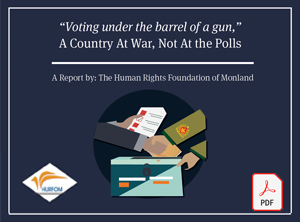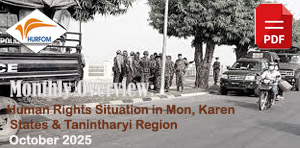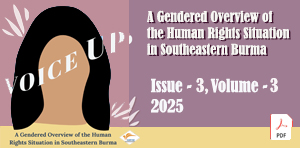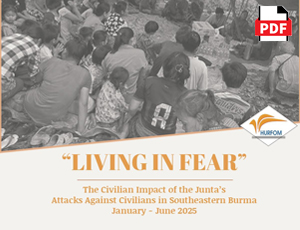Burmese Migrants’ Children get a chance to study in Thailand
November 18, 2009
WCRP: Every morning around six in Mahachai, Thailand, dozens of children wearing matching white shirts and pressed blue or brown trousers anxiously wait on the side of the road. Soon the children will board a paused bus and head off to school.
 Mahachai, a bustling town in Southern Thailand, is a popular destination for struggling Burmese citizens. There, migrants find prosperous job opportunities in factories or on farms. However many migrant families cannot afford, or are legally unable, to send their children to Thai schools.
Mahachai, a bustling town in Southern Thailand, is a popular destination for struggling Burmese citizens. There, migrants find prosperous job opportunities in factories or on farms. However many migrant families cannot afford, or are legally unable, to send their children to Thai schools.
“We live a migrant families lifestyle. When we move we take my granddaughter with us [and] we move so much I am so worried about her education,” Said Oo Shwe Main, a concerned grandfather.
With the help of Labor Rights Promotion Network (LPN), the Wat Camphra School in Mahachai created a program specifically to aid Burmese migrant children in assimileating to Thai culture.
The migrant program focuses on basic education, Thai fluency and the dangers of child labor and trafficking.Once a child completes the migrant program they can legally attend any participating Thai School.
The migrant program started in 2007 with only 45 students and 3 teachers. In 2008 enrollment grew to 170 students, although, for various reasons, this year’s attendance dropped to 150. In addition to a semi-steady student body, there are now 4 teachers, 1 Mon, 1 Burmese – both fluent in Thai – and 2 Thai nationals.
Problems with enrolment arise because migrant parents are often so focused on work and survival they cannot properly help or care for their children. In addition, parents are uneducated and do not understand the importance of schooling.
“Many migrant workers send their children to school because the children are too young to work. When the children are old enough they drop out and work with their parents,” Explained Sura Chai, the Mon teacher at the migrant program.
To aid in the situation, LPN staff regularly call parents to emphasize the importance of a good education.“The Thai government does not financially support the migrant program, but when migrant students attend the Thai school they receive the same materials as Thai students,” said Pi San Nyan Ta Tae, the migrant program’s Thai officer.
The International Labor Organization (ILO), Oxfam and Save the Children provide general funding for the program, the HUSSMAN foundation provides materials and Koninkrijk der Nederlanen provides health care coverage. However, the organizations cannot provide for all costs.
The organizations do not cover all costs.“Migrant students pay 1 baht per pen and 2 baht per notebook, which is cheaper than the store price,” said a man who volunteered at LPN.
“The migrant students’ parents also have to pay for the daily school bus, each family paying 300 baht per month. If a family has 3 students they still only pay 300 baht.” Migrant students also receive a discount on most textbooks.
 Students in the prosperous migrant program are a mix of Arakanee, Burman, Karen, and Tovoy although Mon children make up the majority.
Students in the prosperous migrant program are a mix of Arakanee, Burman, Karen, and Tovoy although Mon children make up the majority.
The children are divided into 4 groups, which are determined by age – the youngest are 4 and the oldest are 15. When they become proficient in Thai and the teachers feel they are ready, the children join the Thai students in regular classes.
There are 6 buildings at Wat Camphra School, 5 for Thai students and 1 for the migrant student program. During recess all the students play together. Popular games include football and basketball, while girls often jump rope in shaded areas.
Integration is the overarching focus of the migrant program and each morning the entire student body sings the Thai King Song, prays and does exercises.“We start class at 9am, teach for 2 hours, eat lunch and have recess, then start class again…one of the teachers gives a speech about how to stay healthy and behave politely in Thai culture.
After we continue with the regular curriculum, The students attend class for about 20 hours a week including a little bit of free time before school ends,” explained Sura Chai.
 “I am so happy to attend this school,” said Mi Htaw Pakao, a cheery 10-year old Mon student from the Wat Camphra School’s migrant program.
“I am so happy to attend this school,” said Mi Htaw Pakao, a cheery 10-year old Mon student from the Wat Camphra School’s migrant program.
Mi Htaw Pakao, whose parents are Mon, was born in Thailand and lives with her family in Mahachai. Her parents work in a prawn factory while her grandparents stay at home and care for her. The nomadic family migrated to Thailand from Kaw Kaloy Kyaikmyaw Township, Karen State, Burma.
“When she was young she attended a Thai school, then we moved back to Burma and she attended a Burmese school. When she was in 4th standard we moved back to Thailand and we were unsure if she could keep up at a Thai school. I think now, with the help of the migrant program, my granddaughter will finish her education,” said Oo Shwe Main, Mi Htaw Pakao’s devoted grandfather.
Sura Chai elaborated on the family’s situation, “They have worked in Thailand for about six years… but Mi Htaw Pakao joined the school three months ago. She tries so hard but she is very quiet. She doesn’t like to play sports with the other students, instead she likes to draw pictures and read. Sometimes she’ll jump rope with the other girls.”
According to Thai law, anyone under 18 must attend school. If a child has a Thai birth certificate, public schools have to accept them. Migrant children who rarely have Thai birth certificates attend migrant programs like the one at Wat Camphra School. Currently there are two migrant programs in Mahachai and a growing number of programs throughout Thailand.
“I am not tired from teaching the students, I am happy to be with them… people should not see migrant children as just children – we should think of their futures and how they will mature. I want everyone to think deeply about these children’s lives and their educations; if everyone thought like this we could help more children with their futures,” Sura Chai passionately explained.
Comments
Got something to say?
You must be logged in to post a comment.




















































